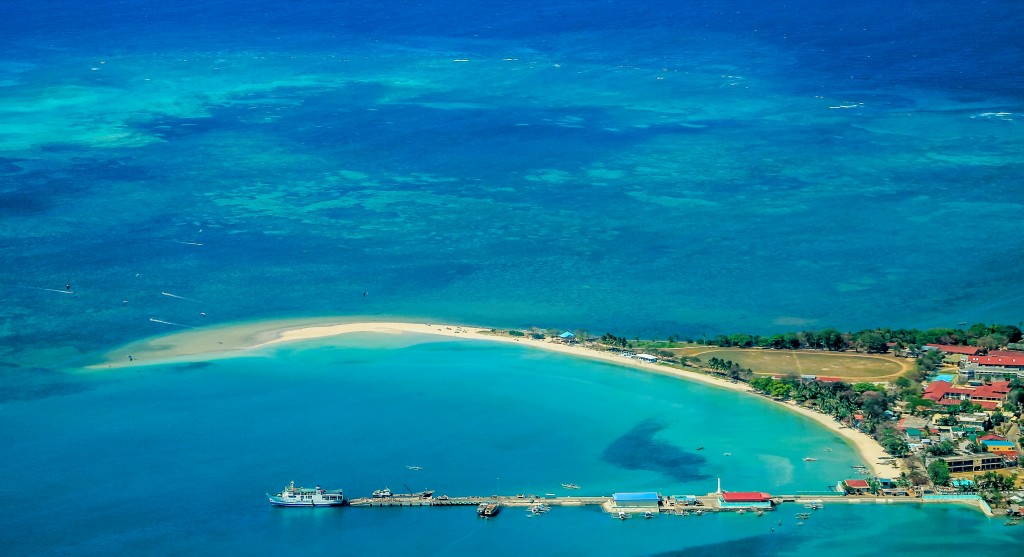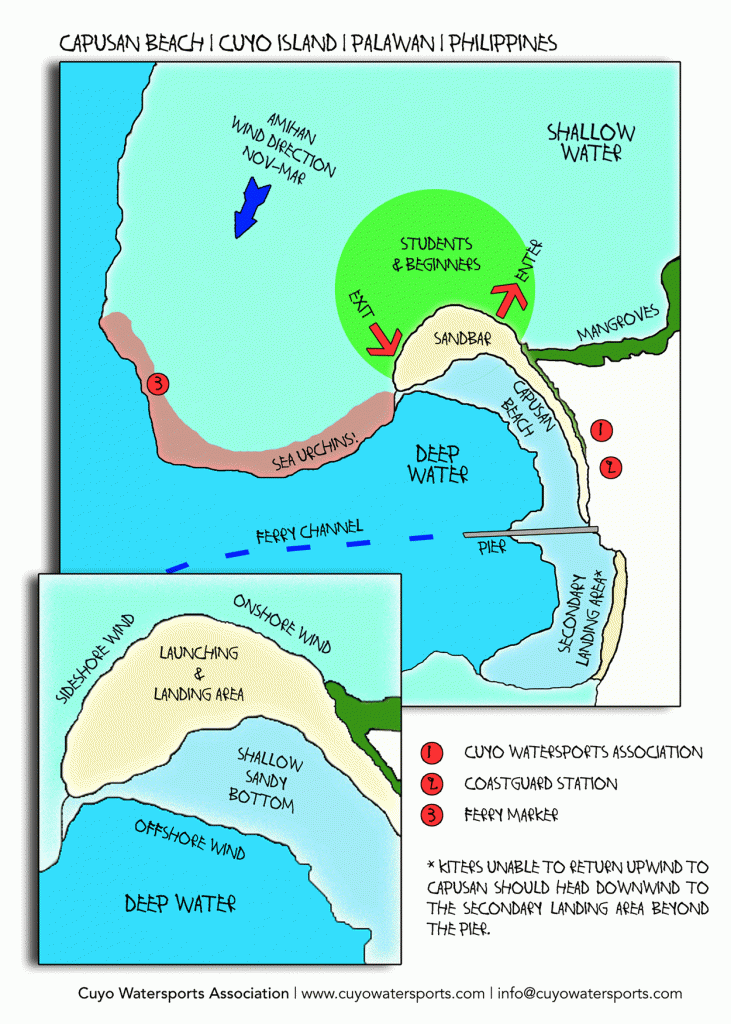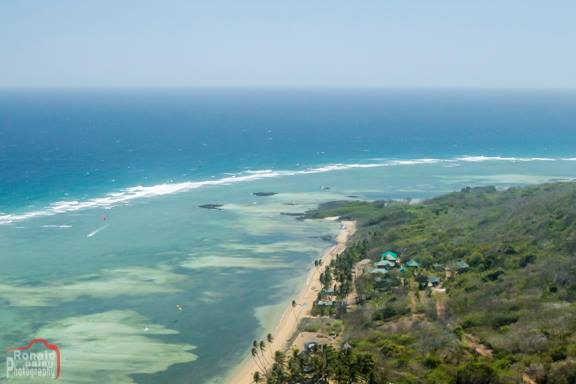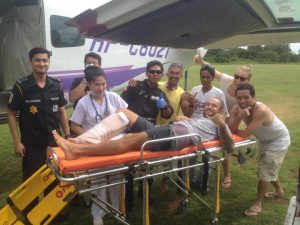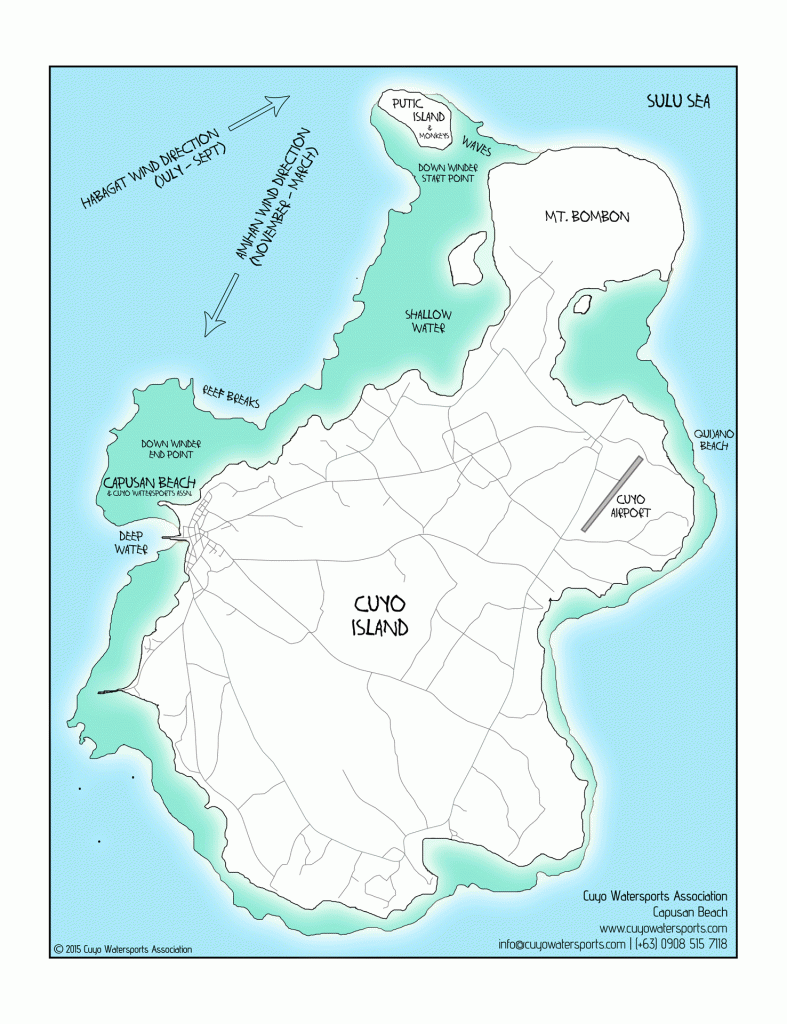
Conditions
Amihan
Every year between December and February Cuyo experiences a steady North Easterly trade wind. Locally this season is known as the Amihan and it is the most popular time for kiteboarding in the Philippines. On Cuyo during this period the wind routinely blows somewhere between 17 and 35 knots.
During the months either side of the Amihan (October, November, March and April), some good winds can be expected, although they are usually lighter and less predictable, typically blowing somewhere between 13 and 25 knots.
Amihan is Cuyo’s dry season so rain is extremely rare at this time of year. Temperatures are generally in the mid to late twenties and a cool sea breeze makes this season the most comfortable. The water temperature averages between 22 and 26 degrees, so kiters rarely wear wetsuits on Cuyo, although appropriate sun protection is essential.
Habagat
July through to September is referred to as Habagat. Habagat is Cuyo’s wet season, when gusty typhoon winds blow from the South West. Kiteboarding is also possible during this time, but the conditions are less suited to beginners or inexperienced kiters.
Habagat is Cuyo’s wet season so the climate is hot and humid with frequent heavy rains. Temperatures often reach the mid thirties around this time.
Water
It is the deep, flat water area between Capusan Beach sandbar and the pier that keeps the pro-riders coming back to Cuyo year after year; perfect for big air & freestyle, the spot is ever popular with Cuyo’s kiting elite. Even during Cuyo’s lowest tides, the spot benefits from deep water.
Please be aware that the wind here blows offshore, so the spot is not recommended for students or beginners. Kiteboarders who find themselves unable to return upwind to Capusan Beach should proceed past the pier, where they will find an alternative shallow, sandy area for self-landing.
On the opposite side of Capusan Beach, there is also flat water, albeit with some slight chop. A 7km stretch of perfect upwind kiting, with almost endless space, the area is often used during the race portion of competition tours; riders on this side of the sandbar typically run out of energy before they run out of space! A steady, consistent, cross-onshore wind, combined with waist-deep shallow water, makes this area perfect for freeriders, beginners, students, and explorers...
Waves can be found at the boundaries of both Capusan Beach and Victoria Beach kite spots.
Tide
Tide times and heights on Cuyo vary greatly throughout the year, but generally extra low tides occur throughout November and December, whilst higher tides occur throughout January and February.
Even at low tide, however, deep water areas can still be found around Capusan beach so kiting is nearly always possible on this side of the island. Kiteboarding at Victoria Beach requires a minimum water depth of 0.5-0.7m.
There are a number of places to find upcoming wind, weather and tide forecasts for Cuyo. We've tried and tested them all, but the jury's still out as to which one's most reliable...
WindGuru
https://www.windguru.cz/208497
Wisuki
In addition to wind and weather forecasts, Wisuki is also a good source for Cuyo tide times. Their app works well on Cuyo, and the Pro version includes informative tide graphs.
Wisuki Tide Forecasts: http://wisuki.com/tide/502/cuyo-islands Wisuki Upcoming Wind/Weather Forecast: http://wisuki.com/forecast/502/cuyo-islands
WindFinder
WindFinder Upcoming Wind/Weather Forecast: https://www.windfinder.com/forecast/cuyo_airport
Locations
Equipment
Kite Gear
During the Amihan season, kiteboarders in the 70-85kg range should bring a 10m kite, as well as a 12-13m kite for light days, and a 7m kite for strong days. Lighter / heavier kiteboarders should adjust their kite sizes accordingly.
Strong days are more likely during the peak of the Amihan winds (December, January and February) while lighter wind days are more common early and late in the season (October, November, March, April) so the timing of your trip may influence what sizes you choose to bring.
Accessories
The water temperature averages between 22 and 26 degrees, so kiters typically don't wear wetsuits on Cuyo. On days when the sky is overcast and the water high, however, temperatures can be cooler, so a thin neoprene layer may preferable.
Decent protection from the sun is essential. This includes plenty of strong sunscreen, sun protective clothing (rashies, hats, etc), and good quality protective eyewear.

Sun protection on Cuyo is serious business...
On Capusan Beach there are patches of large sea urchins around the edge of the reef so booties are advisable, especially for beginners and inexperienced kiters. Our local riders are happy to give advice on which areas should be avoided or kited on with caution.
Repairs
It is a well established fact that Jing does the best kite repairs on Cuyo, if not the whole of the Philippines, so most gear issues can usually be resolved on the island. Replacement parts, however, are often in short supply so if you have space, bring spares!
Kiteboarding Lessons
We love sharing our passion for kiteboarding and take pride in our students and their development. With a large uncrowded and unpolluted, flat, shallow water area and steady onshore and cross-onshore winds, Cuyo is indisputably one of the best spots in Asia to learn kiteboarding.
All our courses put an emphasis on kite control, proper technique, and safe practice. We take our time and progression will be at a pace tailored to each student, suitable to their experience and natural ability. Our goal is to produce kiteboarders who are skilled, safe, and love the sport like we do!
How long does it take to learn to kiteboard?
It typically takes around 16 hours for an absolute beginner to progress to riding independently. All students learn differently though; some get there faster, and some take a little longer. How long it takes will depend on the conditions at the time, your natural ability, and any prior experience (either kiteboarding or another sport with transferable skills like snowboarding, surfing, or wakeboarding).
As a rough guide, students can expect the following at each stage of progression:
1 - 3 hours: Learn the basics of wind and weather, how to assess your conditions and set up and use your equipment. Flying a specialised, short line, small kite on the beach, students will begin to master the essentials of kite control.
4 - 9 hours: Progressing to a full size kite, students will continue to improve their kite control both on land and in water. They will perfect all their self-rescue skills, and take their first steps towards board riding
10 - 16 hours: Students will refine their kite control and riding skills, aiming to master upwind riding, coming to a controlled stop, and changing direction. They should gain the confidence, knowledge, and ability necessary to begin practising independently.
17 hours to forever: Continue refining your skills and technique. Start landing jumps, or perfecting your unhooked triple whim-wham backslap... Kiteboarders never finish learning to kiteboard!
How many hours will I do each day?
Again, this depends on the conditions at the time, as well as your own stamina and eagerness! Whilst it's possible to learn to kiteboard in as little as a couple of days, most people choose to do only two or three hours each day and will take one or two rest days along the way. In this case, a full 16 hour beginner course usually takes around a week to ten days to complete. As always, our instructors will tailor the course to suit your requirements.
How much does it cost?
All lessons are PHP 1500 per hour (approximately USD $30, depending on current exchange rates). Students may take as many or as few hours of tuition as needed.
Does the price include equipment?
Yes, it includes all your kiteboarding gear, as well as helmets, buoyancy aids, booties, and sun protective clothing if required.
I can already kiteboard independently - What's next?
Once you've mastered kiteboarding independently, you may wish to progress to the next level by taking an advanced lesson. CWA uses two-way bluetooth headsets which allow you to ride with your instructor and receive one on one real-time feedback and adjustments to your technique - In our experience, this is the best way for experienced riders to progress rapidly.
Do I need to book in advance?
Due to the unpredictable nature of wind and weather, we are unable to guarantee any lessons in advance.
That said, it always helps if we know you're coming so please drop us a line at info@cuyowatersports.com, detailing your expected arrival and departure dates, any prior experience, and anything else you think might be relevant! After you arrive on Cuyo an instructor will assess your needs schedule your lessons accordingly.
Any more questions?
Please get in touch! info@cuyowatersports.com
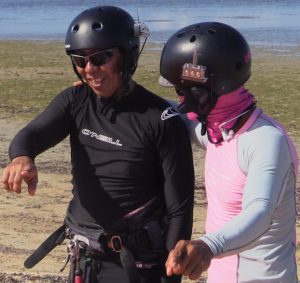 Once you’ve mastered kiteboarding independently, you may wish to progress to the next level by taking an advanced lesson.
Once you’ve mastered kiteboarding independently, you may wish to progress to the next level by taking an advanced lesson.
Whether you want to improve your technique, start landing jumps, or perfect your unhooked triple whim-wham backslap, our instructors will tailor a course to suit.
Intermediate & Advanced Progression
At CWA we use two-way bluetooth headsets which allow you to ride with your instructor and receive one on one real-time feedback and adjustments – In our experience, this is the best way for experienced riders to progress rapidly.
How much do lessons cost?
All lessons are PHP 1500 per hour (approximately USD $30, depending on current exchange rates). Students may take as many or as few hours of tuition as needed.
Does the price include equipment?
Yes, it includes all your kiteboarding gear, as well as helmets, buoyancy aids, booties, and sun protective clothing if required.
Do I need to book in advance?
Due to the unpredictable nature of wind and weather, we are unable to guarantee any lessons in advance.
That said, it always helps if we know you're coming so please drop us a line at info@cuyowatersports.com, detailing your expected arrival and departure dates, any prior experience, and anything else you think might be relevant! After you arrive on Cuyo an instructor will assess your needs schedule your lessons accordingly.
Staying Safe
Hazards
On Capusan Beach there are patches of large sea urchins at the edge of the reef, between the tip of the sandbar and the ferry marker. Kiters should try to avoid this area, especially at low tide. Shells and other sharp debris on the seabed can also cause injuries, so some kiters may choose to wear booties.
Quijano/Victoria Beach also has some sea urchins, although they are regularly removed by the team from Anino Retreat.
There are small sharks around Cuyo, but large predatory sharks are unheard of. Stonefish are known to exist in the area, but are extremely rare.
During Amihan the wind blows offshore between Capusan Beach and the pier. Inexperienced kiters should stay on the opposite side where the wind blows onshore or cross onshore. Kiters who find themselves unable to return upwind to Capusan Beach should proceed downwind beyond the pier, where they will find a flat, shallow area, with space for a self landing or self rescue.
Emergencies
The risk of injury and accident for those engaging in an inherently hazardous sport like kiteboarding is universal.
Kiters on Cuyo should be aware that as with the rest of the Philippines, medical resources on the island are limited. Cuyo has a hospital, several pharmacies and an airstrip for medical evacuations. Nevertheless, visitors are advised to bring ample supplies of any medicine or treatment they might require while on Cuyo, and to invest in a comprehensive medical insurance package before they travel.
There is a Coastguard service available to assist in emergency situations on the water. They are stationed on Capusan Beach behind the market.
Travel Insurance
Medical Treatment and procedures available on Cuyo are extremely limited. Anyone experiencing serious illness or injury whilst on Cuyo will almost certainly need to travel to the mainland for proper treatment. For this reason, we strongly recommend all foreign visitors to Cuyo, especially kiteboarders, obtain suitable travel insurance before they arrive.
Staying Safe
Your ability to safely and completely depower and drop your kite and otherwise manage in an emergency will weigh heavily on your technique, preparation, prior practice and the reliability of your gear.
Please refer to Cuyo's Kiteboarding Code of Conduct for tips on keeping yourself and other beach users safe.
Kiteboarding Safely
Many kiting accidents can be avoided if kiters are informed of safety procedures and exercise reasonable care. Kiteboarding can be hazardous to riders and to bystanders, particularly if practiced without adequate training, safety gear, observation of safe kiteboarding practices and appropriate caution.
Riders must accept that even if these guidelines are followed, that accidents, injury and even death may occur in the sport of kiteboarding.
Kites can produce powerful force with little or no warning. Sudden wind gusts, improper line attachment, mishandling, etc., can result in dragging and/or lofting, possibly with no time to effectively react. A kiter may not always be able to just let go or kill the power of the kite, as many accidents have established.
Your ability to safely and completely depower and drop your kite and otherwise manage in an emergency will weigh heavily on your technique, preparation, prior practice and the reliability of your gear.
Cuyo Kiteboarding Code of Conduct
The following guidelines have been created to improve beach safety for kiteboarders and other beach users; to minimize the potential of complaints and create an environment that will be conducive to providing continued access for kiters to existing kiteboarding locations around Cuyo.
-
Proactively assist other kiteboarders
-
Get adequate training
-
Kiteboard within your limits
-
Always use a kite leash and quick release
-
Launch, ride and land well away from bystanders, beginner kiteboarders and other water crafts
-
Obey Right-of-Way rules for other kiteboarders and water craft
-
Be aware of the weather
-
Beware of sharp objects or stinging animals
-
Conserve space on the beach
-
Keep the beach and ocean clean
-
Any form of teaching is strictly prohibited unless authorized
-
Have fun and smile!
-
Proactively assist other kiteboarders
-
Offer to assist other riders with launching and landing using visual and audible communications such as tapping the top of the head to indicate that you require assistance with landing a kite and the universal “thumbs-up” to indicate you are ready for your kite to be launched. NEVER release a kite for launch until you receive an unequivocal thumbs-up signal from the kiter.
Whether you are starting out or are almost a pro, your help may avoid serious injury and/or property damage.
-
-
Get adequate training
-
Kiteboarders, particularly beginners, should seek adequate, quality professional instruction. Beginners must avoid crowded areas; particularly as kite control is still being developed. Beginners should body drag out at least 60m from shore prior to water starting. Build your skill and experience carefully in side shore or side onshore winds less than 25 knots.
-
-
Kiteboard within your limits
-
Know your equipment’s limitations as well as your own. If you aren't 100% healthy or in doubt, DON’T GO OUT!
-
Don’t fly under the influence of drugs or alcohol.
-
Always maintain an energy reserve while kiteboarding you may need it to help yourself or someone else.
-
-
Always use a kite leash and quick release
-
Make sure you have proper safety equipment, such as a tested, well maintained kite leash securely attached to your harness, and ideally, a quality, well-fitting helmet and impact vest.
-
Regularly test and maintain your chicken loop or kite depowering quick release.
-
-
Launch, ride and land well away from bystanders, beginner kiteboarders and other water crafts
-
Give way to the public on the beach and in the water at ALL TIMES. Be courteous and polite to bystanders; complaints have frequently led to bans and restrictions on kiteboarding and continue to do so.
-
NEVER launch, ride or land upwind of nearby bystanders, and while it may not always be possible, work to keep a minimum 100m buffer zone from beginner kiteboarders (especially when being taught) and fishermen out on the water, they depend on catching fish for their livelihood and do not want to be disturbed.
-
-
Obey Right-of-Way rules for other kiteboarders and water craft
-
Never force your right-of-way over other craft when on the water. Wind shadows and wake chop can cause you to lose control of your kite and end up in the path of other watercraft. Regulations require that no matter who has designated right of way, all watercraft must avoid potential collisions in all circumstances.
-
When two riders are on opposite tacks and there is a need to alter course to avoid collision, the port tack rider (left shoulder forward) shall alter course and/or kite position in order to keep clear of the starboard tack rider (right shoulder forward) who should maintain the same course and speed.
-
When two or more riders are on the same tack with kite lines overlapped, the upwind rider(s) shall keep their kite high and the downwind rider(s) keep their kite low.
-
A rider shall not jump if there is any danger of possible collision with another rider.
-
When wave riding, the first rider on the face of a wave has right of way. This may override the starboard tack rule.
-
Kiteboarders exiting the water have right-of-way over kiteboarders entering the water; they may have a problem with their kite or could be injured and require an immediate landing.
-
Always give way to kiteboarders who are body dragging or not riding in the water.
-
-
Be aware of the weather
-
Is the forecast and current weather acceptable, free of pending storm clouds and excessive gusty winds? Lightning can strike well ahead of approaching storm fronts. Static electricity in the air is a clear sign of an impending lightning strike. Get out of the water well ahead of storm fronts.
-
Are seas and wind condition within your experience, ability and appropriate for your gear? New kiters should practice in lighter, side or side onshore winds.
-
-
Beware of sharp objects or stinging animals
-
The sea bed on the north / north eastern side of Capusan beach may contain sharp object such as glass or tin cans which can cut your feet if not protected.
-
There are large sea urchins from the end of the sand bar on the far North Western side of Capusan beach to the marker out on the reef, avoid this area if possible, especially at low tide.
-
-
Conserve space on the beach
-
Roll up your lines when your kite is on the beach and don’t leave your kite on the beach for extended periods.
-
Don’t stand on the beach (chatting) with your kite over the water or above your head.
-
-
Keep the beach and ocean clean
-
Please help keep our beach and ocean clean, take your rubbish with you or dispose it in the bins provided. If you see glass on the beach, pick it up, it could be your kite/foot that lands on it when you come back.
-
-
Any form of teaching is strictly prohibited unless authorized
-
Cuyo’s kiteboarding instructors are experienced and professional and know what to do in an emergency should anything go wrong. If you are not an experienced instructor you are endangering Cuyo’s reputation as a safe, fun place to kiteboard.
-
Cuyo is committed to preserving its community and improving the lives of its inhabitants. All lessons are to be taught by individuals with all necessary permits and rights to work.
-
-
Have fun and smile!

